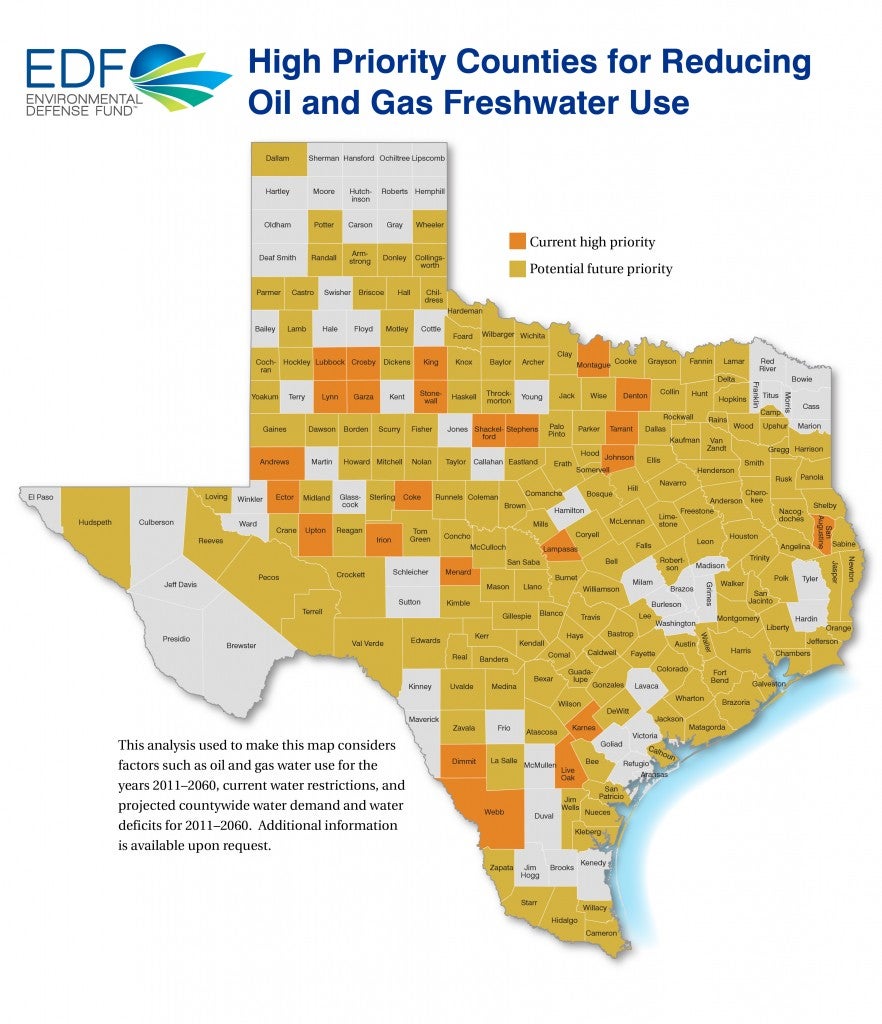Texas is suffering from a water deficit; one that is spurring lawmakers at the Texas Capitol to discuss unprecedented, and much needed, investments in our water infrastructure. With roughly 98 percent of the state in drought and water use restrictions in place in 70 percent of Texas counties as of April 3, 2013, it is crucial that our legislators consider every tool available to protect Texas’ water supply. One approach is reducing freshwater use in the oil and natural gas sector, which can help alleviate competition for scarce water resources; however, this should be deployed at strategic places and times to minimize pollution risks and ensure a sustained future water supply for Texas.
In the Texas Legislature, the House recently passed a bill which will provide $2 billion to fund water supply projects. It might surprise you to hear that this high price tag represents less than 10 percent of the state funding that will be needed over the next 50 years to sustain water supplies for Texas’ growing population. In light of this, it is essential that legislators enact bills that encourage responsible water management solutions. Although the oil and gas industry’s water use appears miniscule when considered on a statewide basis, even small amounts can have a big impact in the most water stricken areas. EDF created a map of the counties in Texas currently being impacted by water scarcity and that would benefit greatly if the oil and gas sector reduced its use of freshwater.
Data used to create the map revealed the following:
- The majority of water used for Texas oil and gas development in 2011 was in 13 counties, ten of which currently have water restrictions in place.
- For 12 counties, oil and gas water use made up at least 25 percent of overall county-wide demand in 2011.
- In 15 counties, oil and gas water use is projected to be greater than or equal to 25 percent of the water deficit in those counties in 2020.
- In five counties, 100 percent of the water deficit projected for 2020 can be met by cutting oil and gas water use by half.
The oil and gas industry is a prime candidate for reducing its reliance on freshwater because – unlike the agriculture and municipal sectors – using non-freshwater is technologically feasible. Some of the most popular alternative water sources for the oil and gas industry include brackish (or salty) water, treated flowback water from hydraulic fracturing and reclaimed water from public wastewater treatment plants. Taking advantage of these options could be a win-win-win for industry, people and the environment.
Nonetheless, legislators should be aware that pre-treating brackish, flowback or reclaimed water prior to use in hydraulically-fractured wells produces a solid waste byproduct containing potentially harmful materials. Additionally, it is riskier to store and transport brackish water than freshwater. Any legislation considering incentives for or mandating use of alternative water sources for the oil and gas industry should also include rules for minimizing environmental risks associated with the waste stream that is generated from pre-treating, storing and transporting alternative water sources.
Although most Texas counties would receive some benefit from reduced freshwater use from the oil and gas sector, there are at least 24 counties where this would largely remedy county-wide water deficits over the next seven years. But as the oil and gas boom continues in Texas, it will be important for agencies to also continue to collect and analyze data on changing water use trends in each county. That way, our scarce water resources can be protected and available for future generations.
Rules that encourage the use of alternative water sources will be incredibly helpful to communities that need freshwater during this time of drought. However, the best rules will be those that manage risks from the storage and transport of brackish water and from the treatment byproduct waste stream, collect and analyze data for appropriate water and waste management and allow flexibility to account for changes in use that occur over geography and time.
EDF is also working on solutions to improve efficiency at the water-energy nexus, acknowledging the inter-dependent nature of producing water and energy at a time when Texas is facing resource restraints in both.









